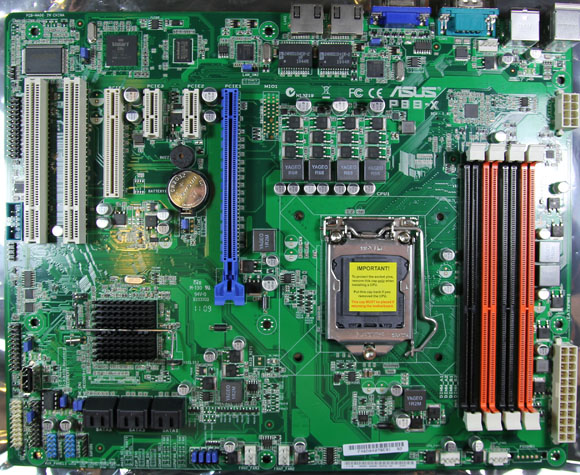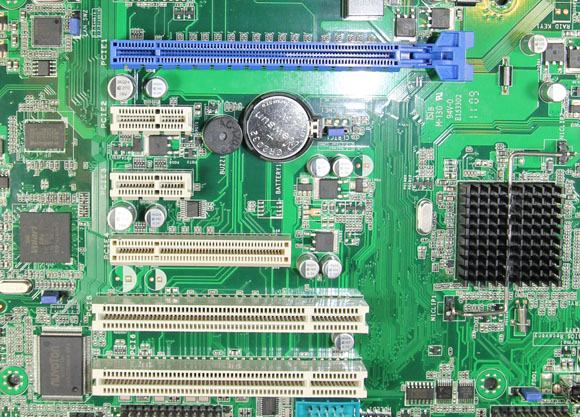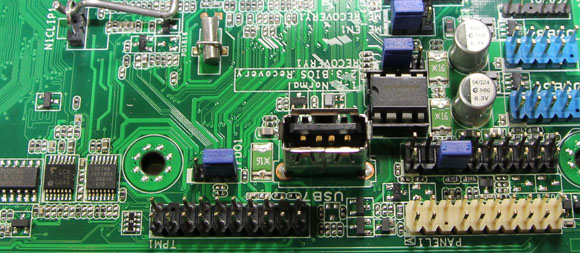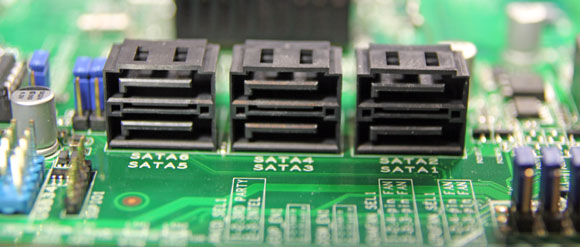The Bromolow platform with Sandy Bridge E3 Xeons and C200 series chipsets provides a very low-power platform for small business and home servers. Starting with the new Intel Xeon E3-1230, users get both low power consumption as well as four cores and eight threads when combined with a motherboard, such as the ASUS P8B-X, yields a total cost of less than $450. The ASUS P8B-X has several features that make it well suited to the uni-processor (UP) server market.
Test Configuration
With the new LGA 1155 Xeon E3 series CPUs sporting AES-NI encryption acceleration, servers built on the new Sandy Bridge architecture have a clear advantage in the storage space since AES encryption can be used to safeguard important data without a CPU bottleneck. The ASUS P8B-X allows a user to build a server platform with a mix of add-in cards.
- CPU: Intel Xeon E3-1280
- Motherboard: ASUS P8B-X C202 Motherboard
- Memory: 8GB ECC 1333MHz CL9 DDR3 (4x2GB)
- OS Drive: OCZ Agility 2 120GB
- Additional NICs: Intel Gigabit CT PCIe x1 network adapter, Intel Pro/1000 GT PCI network adapter
- Enclosure: Norco RPC-4224
- Power Supply: Seasonic X650 (650w Gold level power supply) PicoPSU 150XT with 150w power supply
A quick recap of the Bromolow platforms shows that the C202 chipset does not support the onboard video of the Xeon E3-12×5 series chips (e.g. the Intel Xeon E3-1235) so one can save a decent amount of money purchasing one of these over a C206 board and E3 CPU.

Board Layout
The ASUS P8B-X is a standard ATX form factor board, and is fairly similar in design to most server boards.

One major difference between the Intel C202 and other Bromolow platforms such as the C204 and C206 is that the C202 based boards have six SATA II 3.0gbps instead of the four SATA II and two SATA III ports found on other Sandy Bridge boards. Using the new generation of SSDs, it is more than possible to utilize 6.0gbps speeds that SATA III offers, however, most six disk storage servers are going to use rotating disks which are not limited by the SATA II 3.0gbps interface speed making the point moot. In fact, the ability to use all six drives in the same array is an advantage of the C202 chip set.
The ASUS P8B-X SATA ports are mounted parallel to the PCB plane and recessed from the edge of the board. While this is not a big feature for users that are utilizing traditional rackmount server chassis, users utilizing smaller-sized ATX cases, such as the class Antec Nine-Hundred to build a low-cost and quiet server will especially like this feature. With recessed SATA ports, one gains a bit of room for cable installation. With its UEFI BIOS, the P8B-X can support booting from drives in excess of 2.2TB, namely the current batch of 3TB drives and the soon-to-be announced 4TB drives. Beyond this, the ASUS P8B-X has a lot of expandability:

As one can see, the ASUS P8B-X has several options for a user to fit add-in cards. The first slot is a PCIe 2.0 x16 slot which allows one to utilize a high-quality RAID controller easily if one wants more drives. Both PCIe x1 slots are good for things like additional Intel CT Desktop Adapters or for those running media servers, PCIe x1 TV tuners. The PCIe x4 slot is a nice addition with more versatility. One thing I would have liked to see there would have been an open-ended slot which would allow a user to install PCIe x8 length cards into the slot even if they operate at PCIe x4 speeds. Rounding out the expansion slot list are two PCIe slots. These PCI slots are nice for legacy cards such as PCI based WiFi cards or Intel Pro/1000 GT NICs if one has extra cards they plan to migrate from older systems.

Rear I/O provides two PS/2 ports for a keyboard and mouse, two USB ports, a serial port and VGA out port. This is a fairly typical server specific set of I/O because servers tend to focus more on low power and low cost video with VGA out only instead of the more expensive DVI, HDMI, and DisplayPort technologies. Probably the really exciting feature is dual Intel 82574L Gigabit Ethernet controllers. Some manufacturers are using the lower-cost on-chipset Ethernet of the Bromolow platform, but the Intel 82574L is perhaps the #1 most used server LAN chip over the past few years meaning it is compatible with just about everything out of the box.

One can also see that ASUS fortified the board with an Internal USB header which is a feature that should be found on every server motherboard these days since one can install an internal USB header. For those working with FreeNAS or unRaid servers, this internal USB header can be extremely handy.
Conclusion
The ASUS P8B-X provides solid features for the segment the board competes in. It does not have KVM-over-IP features which many users will want, but what it does have is a below $200 MSRP and lots of expansion options. Further, compatibility with things such as VMware ESXi are made easier by having two supported NICs already onboard and plenty of room for others. Overall this is a solid choice for users looking for a solid board to pair with the Sandy Bridge Xeon E3-12×0 series CPUs.
Feel free to discuss on the ServeTheHome.com Forums!





I wonder if Intel Xeon E3-1230 would work on some standard desktop motherboards, like Asus P8P67 (not WS revolution model, which is of course supported, but I’m not interested in that one)
Solitary, I have tried the chip in some H67 boards and can confirm it does work. Much like the Xeon X3440 works in P55 boards (albeit without ECC support.)
consider buying the P8B-X for my esxi machine, can anyone confirm its working with a intel core i5 2500 and ddr3 non ecc ram ?
Confirming ASUS P8B-X “WILL NOT WORK” on Non-ECC 1333 DDR3 Rams.
Tested on 4x 4GB Samsung DDR3 1333 Non-ECC Rams.
Result: Non display signal, no beeping, no message on the screen, completely silent.
Bad news, I need to see if I can exchange for the more expensive ECC Rams tomorrow.. =*(